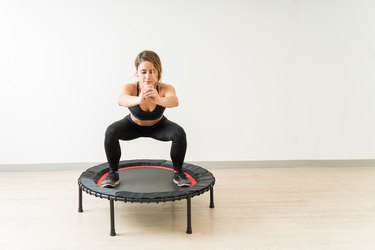
Intense workouts increase energy expenditure and facilitate fat loss. The number of calories burned rebounding on a mini trampoline can be enough to help you get leaner. However, the results depend on your diet and lifestyle, as well as your workout.
Tip
Rebounding is a low-impact, vigorous workout that can help you get leaner. How fast you'll get results depends on your diet and body weight as well as workout intensity and frequency.
Video of the Day
Calories Burned Rebounding
A small study published in the February 2017 issue of Science & Sports has found that the average heart rate during a rebounding workout was around 132 beats per minute. The average number of calories burned rebounding was approximately 320. Based on these findings, researchers concluded that rebounding could be classified as a vigorous form of exercise.
Video of the Day
You can classify rebounding workouts as aerobic exercise rather than resistance training. While you might feel a burn in your legs during training, it's more about raising your heart rate and making yourself breathe hard. Depending on how fit you are, it could be a very intense workout.
Another small study, which was published in the European Journal of Sports Science in March 2018, has tested two groups: one that had endurance training and one that didn't. Endurance-trained subjects had an easier time during the workout compared to the other group. Researchers measured the results by using VO2, which shows how much oxygen people consume during exercise.
The above study points out that rebounding is a low-impact exercise. Since it's gentle on the joints, people who are unable to run or do plyometrics could use it as an alternative form of training.
Read more: The Mini Trampoline Workout You'll Feel All Over
Lose Fat and Gain Muscle
Rebounding workouts may help some people lose weight and get healthier. In a small study featured in the Journal of Sports Medicine and Physical Fitness in March 2018, women with obesity who engaged in a mini trampoline workout program for 12 weeks lost body fat and got more fit. They also gained muscle and improved their blood pressure.
Another small study has found that 20 weeks of trampoline training helped adolescents lose weight. Subjects experienced significant reductions in body fat and improved their fitness level. Their training program consisted of 4 workouts per week, with each workout lasting 1.5 hours. The results were published in the International Journal of Preventative Medicine in July 2016.
These findings show that you can expect to lose weight within 12 to 20 weeks of starting a rebounding exercise program. However, keep in mind that the above programs were not easy. The subjects worked out several times per week, and the sessions lasted over an hour in some cases.
Not only you have to put effort into your rebounding workouts to get results, but your diet may need to change. To lose weight, you need to be in a negative energy balance, according to the National Heart, Lung and Blood Institute. This means you have to take in fewer calories than you burn each day. Over time, you will begin to lose body fat if you're consistently in a negative energy balance.
Dial In Your Diet
When you work out on a rebounding trampoline, calories burned daily will go up, which brings you closer to a negative energy balance. If you start a workout program and you're not seeing results, your diet might be the culprit. Lowering your daily calorie intake may help increase your energy deficit and speed up your progress.
Read more: 7 Small Diet Changes That Yield Big Results
Changing your diet can be difficult, so you might want to seek professional help. A registered dietitian can guide you by figuring out which foods work best with your body. If you decide to do it alone, you can use a few strategies to cut calories.
The Centers for Disease Control and Prevention (CDC) explains that it's not necessary to eat less to cut calories. Sometimes, all you need to do is change the types of foods you're eating. They suggest choosing veggies and other high-fiber foods that promote satiety. Sugar, for example, contains many calories but has no nutritional value and doesn't fill you up.
The CDC also recommends replacing sugary drinks with water because liquid calories can lead to weight gain. Furthermore, you can swap high-calorie foods for healthier options. Consider replacing whole milk with low-fat milk and dairy, white rice with vegetables or legumes and potato chips with air-popped popcorn.
- Centers for Disease Control and Prevention: "Cutting Calories"
- National Heart, Lung, and Blood Institute: "Balance Food and Activity"
- International Journal of Preventative Medicine: "Effect of a Trampoline Exercise on the Anthropometric Measures and Motor Performance of Adolescent Students"
- The Journal of Sports Medicine and Physical Fitness: "Effects of a Mini-Trampoline Rebounding Exercise Program on Functional Parameters, Body Composition and Quality of Life in Overweight Women."
- Science & Sports: "Exercise Intensity and Energy Expenditure During a Mini-Trampoline Rebounding Exercise Session in Overweight Women"
- European Journal of Sports Science: "Oxygen uptake during mini trampoline exercise in normal-weight, endurance-trained adults and in overweight-obese, inactive adults: A proof-of-concept study"